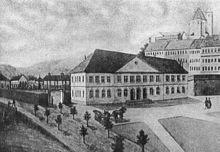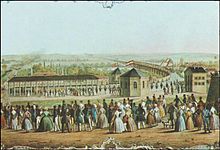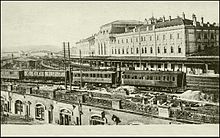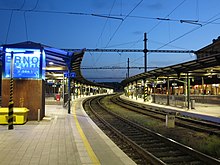Brno hlavní nádraží
| Brno hlavní nádraží | |
|---|---|
 Reception building, street side
|
|
| Data | |
| Operating point type | Train station (Stanice) |
| Location in the network | Separation station |
| Design | End station / through station |
| Platform tracks | 10 |
| abbreviation | Brno hl.n. |
| opening | December 15, 1838 |
| Architectural data | |
| Architectural style | Art Nouveau |
| architect | Josef Nebehosteny |
| location | |
| City / municipality | Brno |
| Okres | Okres Brno-město |
| region | South Moravia |
| Country | Czech Republic |
| Coordinates | 49 ° 11 '28 " N , 16 ° 36' 47" E |
| Height ( SO ) | 205 m nm |
| Railway lines | |
|
|
| List of train stations in the Czech Republic | |
Brno hl.n. (German: "Brno Central Station") is the central passenger station in the railway junction Brno ( Brno ). It is located immediately east of the old town and goes back to the stations of the kk priv. Kaiser Ferdinands-Nordbahn and the kk Nördliche Staatsbahn from 1838 and 1849.
Today the Brno Central Station is an important hub station on the Pan-European Railway Corridor IV from Dresden to Southeast Europe . As of the 2017 annual timetable, the station will be used by direct international long-distance trains on the Hamburg – Berlin – Budapest and Prague – Vienna – Graz routes.
Location in urban space
The Brno railway station was laid out in 1838 before what was then the “Ferdinand's Gate”, which was newly built in 1835, i.e. directly in front of the city gates between the moat and the city wall. Today it is still located almost exactly in the same place, southeast of the city center, the reception building is now only a little further northeast. To the southeast it borders on the Trnitá district. The marshalling and freight facilities are now outside the station at more distant locations, e.g. B. Brno dolní nádraží . Most of the tram lines with a stop in front of the train station, not far from the former facilities of the StEG train station, there is now a central stop for trolleybus, omnibus and other tram lines. An underpass, starting from Josefská, runs under the station forecourt (Nádražní) and the train station, then connects the city center with the train station and the central bus station Zvonařka via bridges and shopping centers.
history
In the course of history, the Brno train station has undergone several extensions and renovations due to the steadily increasing volume of traffic.
Railway station 1838–1849
After Vienna and Budapest, Brno was the third major city of the Austro-Hungarian Empire and the first in the Bohemian Lands to have a railway connection, in this case to the Emperor Ferdinand's Northern Railway . It led from Vienna via Lundenburg to Brno and in the other branch from Lundenburg to Krakow and Bochnia . The first station in Brno was laid out as a terminus in 1838, before what was then the "Ferdinandsthore", which was newly built in 1835. Usually it is called North Station / Severní nádraží for short, correctly: Station of the Emperor Ferdinand's Northern Railway / Nádraží Severní dráhy císaře Ferdinandovy. To do this, engineer Carl von Ghega had to bridge both Schwarzawa and Wiener Strasse. This was followed by a 637 m long viaduct with 72 arches, built in an arch and with an incline, to reach the station. The locomotive “Moravia” was already seen there on November 11, 1838, the Brno Raigern line was opened on December 15, 1838, and the entire line was opened on July 7, 1838, with the strong participation of the population. The train took 4¼ hours to cover the 144 km from Vienna to Brno.
Railway station 1849–1869
The city got the second station in 1849 in connection with the construction of the Imperial and Royal Northern State Railway from Brno to Česká Třebová and on to Prague. This station is called the State Station / Státní nádraží. Both station grounds were directly next to each other and were connected by tracks, so that a new, symmetrical station building was built as a community station with one wing each for each railway company in place of the station building of the Kaiser Ferdinands-Nordbahn that had only been built 10 years earlier . The redesign was carried out by railway engineer Anton Jüngling . In addition to the expansion of the technical facilities of the KFNB located south of the ground floor, such as locomotive sheds, warehouses, workshops and goods facilities, the StEG was rebuilt south of the reception building on the other side of the Nádražní / Křenová street, which had to be bridged for this purpose.
The third station was the Rossitz station (today Brno dolní nádraží ) of the Brno-Rossitz railway at the end of Thornrössel Street (ulica Trnitá) in the Trnitá district. There the route began via Strelitz ( Střelice ) after God's blessing (today Zastávka with its coal mines).
Railway station 1869–1883
In 1869 the line Brno – Přerov of the KFNB was opened, which also from the south, crossing the Rossitz line, together with the line from Lundenburg, merged into the station of the KFNB.
Constant competition and quarrels between the KFNB and the StEG characterized this and the following years, which also had an impact on the railway projects and the routing as well as the Brno train stations.
When the line from Strelitz to Grusbach ( Hrušovany nad Jevišovkou ) was opened in 1870 and the connection to the Eastern Railway was established by the Imperial and Royal Northern State Railway , the line continued to lead in Ober Gerspitz ( Horní Heršpice over the Kaiser Ferdinand Northern Railway ) Rossitz railway station and through this via a newly built connection on a high embankment along the Trnitá street to the state railway station of the Northern State Railway . In 1869/70 the station facilities were therefore expanded and rebuilt again, this time by the master builder Josef Arnold . The Rossitz train station is converted into a freight yard in the same year.
In 1877 the Brno-Rossitz Railway was taken over completely by StEG after it had been leasing it for use since 1870.
Railway station 1883–1902
From 1883 to 1888 the route to the Vlarapass ( Brno – Vlárský průsmyk ) was built by the StEG. A connecting curve was also set up from this route via Židenice to the route to Česká Třebová . Likewise in 1886 the extension of the Rossitz Railway from Segen Gottes ( Zastávka ) to Iglau ( Jihlava ) with connection to the Austrian Northwest Railway was built as part of a “ Bohemian-Moravian Transversal Railway”. Thus, the route from Iglau via Strelitz through the Rossitz train station to the state train station. In 1885 the StEG opened the Brno – Tischnowitz line . The station facilities will be expanded again in these years, and at the same time both parts of the station will receive the most modern goods handling facilities of the time .
Railway station 1902 – today
From 1902 to 1905 the main station was rebuilt again. Since then, all trains have started and ended in this station, as a connection from the Rossitzer Bahn to the KFNB was built in 1904. That is why the station is now called "Centralbahnhof" or simply Brno Station. In 1905, the Brünn – Tischnowitz – Deutsch Brod line went into operation. In 1906 the KFNB was nationalized into the kkStB , in 1907 the latter also took over the business, so that the management in Brno was finally in one hand.
In 1927 a large connecting curve ( Komárovská Spojka ) was built from the main train station to the Brno-Wlarapass route. This simplified the management to the east considerably.
In 1945, 1953 and 1962 further changes and improvements were made to the routes in and around Brno. In 1970 the direct connection between the Rossitz train station and the state train station of 1870 was demolished and gradually built over. However, a small part was preserved when the Vaňkovka shopping center was built.
Due to the difficult and complex history and the resulting unfavorable location of the current station for further extensions, a project has been discussed for several years that will move the station a few hundred meters to the south. A referendum has so far prevented the plans, also due to immense costs. Opponents argue that there are no local transport connections at the new location and that the way to the city center is much further than before. There are several alternative proposals which, however, have not yet led to an agreement. In 2009 it was therefore decided to suspend the negotiations for two years. Financial difficulties and the need to save leave the further outcome of the planning open.

description
Today's Art Nouveau building by the architect Josef Nebehosteny from 1902 to 1905 consists of the main hall with 2 side wings. It was built using the previous structure from 1849. In the main facade to the right and left of the main portal there were originally two clock towers, of which the right one was destroyed after an air raid in 1944 and was not rebuilt. In addition to the impressive Art Nouveau reception hall, the left wing of the station (left of the main entrance) also houses the original station restaurant with Art Nouveau furnishings, the current “Restaurace Secese”. In the past few years, the station's exterior facade has been extensively restored.
Transport links
As of June 2011, 240 passenger trains reached the station every day and the same number left it again. Brno is thus an important railway junction in the south of the Czech Republic. Many of the mainly international connections that existed before 1945 were gradually restored after 1989, e. B. from and to Bratislava , Kúty, Trenčín , Košice , Budapest , Belgrade , Vienna , Binz , Hamburg , Berlin . National connections exist a. to the capital Prague , to Plzeň (Pilsen), České Budějovice (Budweis), Jihlava (Iglau), Břeclav (Lundenburg), Olomouc (Olomouc), Hodonín (Göding), Jeseník (Freiwaldau) and Šumperk (Mährisch Schönberg). Only the former StEG line from Vienna to Brno via Hevlín is still interrupted between Hrušovany nad Jevišovkou and Laa an der Thaya ( Hevlín – Brno railway ).
literature
- Freiherr von Röll: Encyclopedia of the Railway System. Second, completely revised edition. 1912-1923.
- History of the railways of the Austro-Hungarian monarchy. Volume: 1-4. Prochaska, Vienna 1898 (Reprint - Volumes 1-20, 1999 to 2001).
- Hanns Haas, Hannes Stekl (ed.): Bourgeois self-expression. Städtebau, Architektur, Denkmäler , Böhlau, Wien 1998, p. 25ff, ISBN 3-205-98439-0 (section: Pavel Zatloukal: Brünner Ringstraße ).
Individual evidence
- ^ A b Bourgeois self-portrayal: town planning, architecture, monuments. Böhlau, Vienna 1995, pp. 34/35.
- ↑ Timeline (Czech)
Web links
- Historical maps of Moravia and Brno
- ebooks History of the Railways of the Austro-Hungarian Monarchy. Volumes 1-4. Prochaska, Vienna 1898 on openlibrary.org
- About Nebehosteny on the website of encyklopedie brna (Czech)
- History of the railway in Brno (Czech)
- Description of the renovation plans on the Jižní Centrum Brno website
- Harald Buschbacher: Increasing efficiency in rail transport. Lower costs for compression and quality improvement in regional and suburban traffic in South Moravia. (PDF; 5.9 MB) Dissertation. Vienna (short version with a focus on variants of the reconstruction of the Brno railway junction).
- Article about renovation plans on the Radio CZ website






